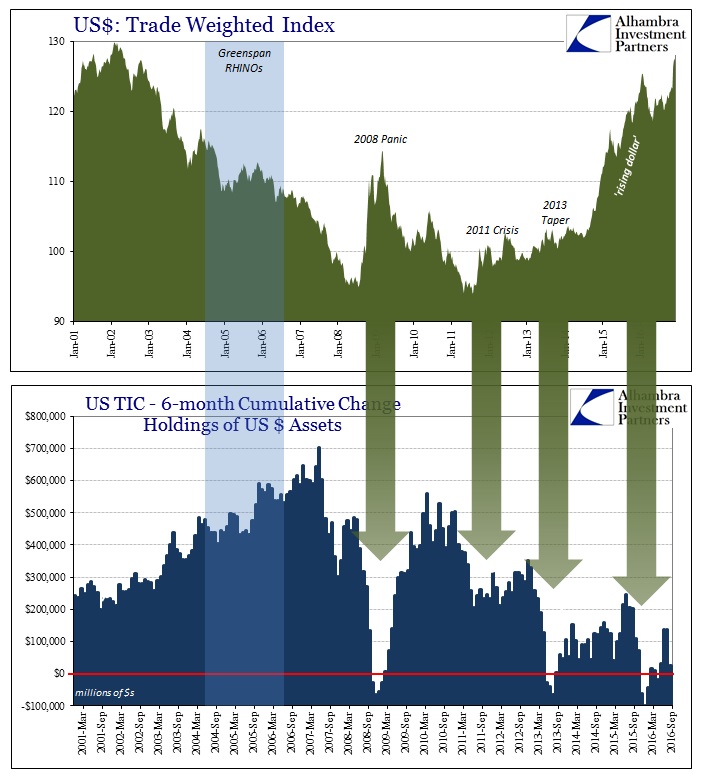On April 27, 2007, the People’s Bank of China announced that it was raising the statutory ratio for required reserves by 50 bps to 11%. The Chinese had allowed their currency exchange rate to moderately float almost two years prior, which changed the way monetary policy would have to work. Without full control of CNY and thus everything moving in and out (far more the former), the country’s monetary system would be at issue where external “inflows” could heavily influence internal liquidity, thus inflation, thus overall economy.
Starting in July 2006, the PBOC had begun to raise the Required Reserves Rate (RRR) not necessarily to “tighten” as it might be understood under Western conditions, but rather to shift its influence from strictly CNY. The level of RRR does not control the amount of money or even deposits, as that is still a matter of this external/internal balance. In other words, money growth would still be very strong based on “inflows”, only now the PBOC would attempt to restrain credit growth no matter how much “hot money” moved in.
In early 2007 it was way too strong. On April 27 that year, the PBOC published the new higher requirement to be effective May 15. Only three days after the effective date, on May 18, the PBOC declared yet another 50 bps hike in the RRR as if in a hurry to slow down monetary momentum. This would continue throughout the rest of that year, where on December 8, 2007, the PBOC raised the RRR for the tenth time just in 2007, and that one for a full 1%.
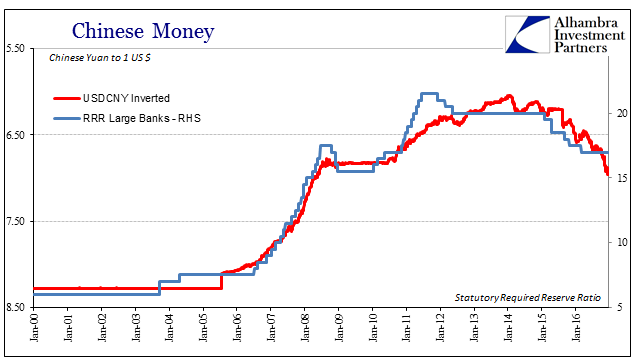
It made for an interesting dichotomy certainly with the United States and the Federal Reserve. Here, monetary officials were struggling with the opposite conditions, if only in certain parts. The banking system was increasingly illiquid, yet oil prices and inflation were running through the roof. The Fed throughout the middle of 2007, at least, didn’t know whether to resume “tightening” or start more “accommodation.” They chose the latter, though only theoretical, as subprime proved far from contained.
I devote a great deal of time and effort on China and its money in particular which to some may seem curious, a sort of niche interest. Economically-speaking, there is no explanation necessary for expending resources analyzing the Chinese economy given its size and prominence as an outlet for global growth. Thus, any outsized interest in its monetary conditions could seem relevant to that task. But my view on China money is that it is more than China, perhaps the least ambiguous indication we have closer to real-time for the “dollar.”
But as the diverging fates of monetary policy China to the US in 2007 showed, we always have to be careful because there is no singular “dollar”; there are only pieces and fragments that can perform as if entirely unrelated until they are reconciled with the whole usually under the worst conditions. The internals of the global USD MBS system and many pieces related to it, including repo, were falling apart at that early point in the crisis, but others that were more outwardly related were acting as if turbocharged.
That latter segment included, of course, oil and other commodities like copper. Though we can never know for sure the actual points of distinction, the eurodollar system in its nascent stages developed first overseas in order to finance global trade exclusively. It was only later especially after 1995 when these eurodollar capacities began to “leak” inside the US to finance things like mortgages and consumer credit.
Systemically speaking, then, it perhaps should not have been surprising to see the portion devoted to more purely financial arrangements, including those parts saturated in the housing bubble in the US, implode as an almost totally separate matter from what “we” still call “hot money.” The outward section of the system had been more so dedicated to funding all those EM growth “miracles”, making it appear as if there really had been a discrete “global savings glut.”
This difference very much echoed emerging economic thought at the time, where the word “decoupling” made its first appearance as worries about the US economy were cauterized by this seeming split in finance (really “dollar”) as well as economy. Without understanding and appreciating eurodollars, it really did look as if the US was alone in its trouble. Not only were the Chinese still raising their RRR to further tame “inflows” of largely “dollars”, lest we forget the Europeans were raising rates, also in early 2008.

In China, they went from one month dealing with the ongoing huge surge of “hot money” to suddenly worrying about full-blown internal monetary contraction. It was as if someone had flipped the “dollar” switch, and in many ways it was exactly like that. It’s not as if oil prices, for example, had been rising on actual “dollar” liquidity, more so the idea of it as the Fed seemed poised to effectively if not overly respond to the contained subprime fiasco.
When the “dollar” market, meaning bank balance sheet constraints, realized their error and the extent of the error, it was night and day different across the entire global financial spectrum. There were no more rate hikes in Europe, and rather than risk further damage as the CNY rate would very likely have started to reverse, the PBOC resumed pegging the exchange rate to the dollar in what has become a very familiar process, though still couched euphemistically as “selling UST’s.”
As you can see on the chart immediately above, the more they pegged CNY the greater the internal illiquidity, leading to several cuts in the RRR later in 2008. Both directions established, we see also very plainly that the CNY rate is a quite good proxy for the “dollar”, or at least some part of it, whether that might be an Asian “dollar” or something even more specific.
These relationships continued on the other side of 2008, too, where in the initial “recovery”, or the times when it looked like it might turn into one, it was as if 2007 all over again. The PBOC began to raise the RRR in the middle of January 2010, a full five months before they finally let go of the CNY peg. We can easily assume that was the resumption of private “dollar” flow alongside the PBOC’s continued “selling UST’s” that also supplied “dollars.”
Though Chinese monetary policy restoration in the RRR paused after the “unexpected” return of potential mayhem in May 2010 with the “flash crash” and sudden interest in Greece, Bernanke’s QE2 later in the year pushed “dollar” flows back to the extreme (not because of the bank reserves created by QE, instead due to bank balance sheet retracement aligned with expectations, ultimately misguided, for QE’s future effects in the real economy and on volatility). Just like May 2007, in November 2010 the PBOC raised the RRR one day (November 16, less than two weeks after QE2 had officially been announced) and announced the next 50 bps hike just three days later.
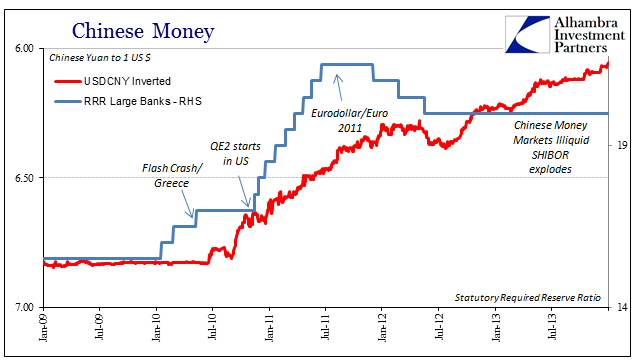
The RRR hikes continued until the sudden re-appearance of global, unified eurodollar problems all over again in July 2011. The RRR was reduced importantly in the first half of 2012 (starting December 2011), just as the global economy slowed. It has yet to recover. Similarly, the RRR has been only lower ever since, as have, it should be pointed out, commodity prices in general. It demonstrates that the RRR is not really about “tight” or “loose” monetary policy in China, as it is so often described, rather it is an indication of this external/internal balance of “dollar” money and Chinese monetary responses to it.
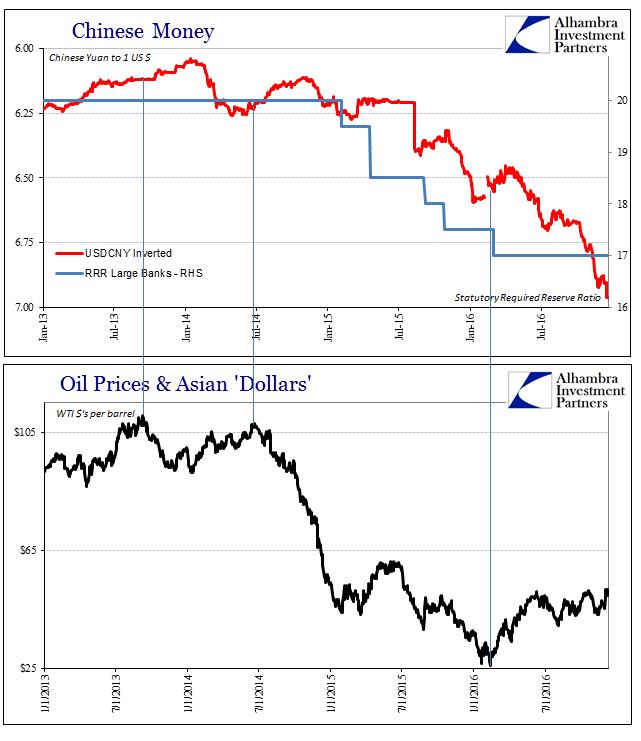
And so it demonstrates pretty conclusively that the traditional standing on global money is false; hot money, outflows, the ridiculous global savings glut, etc. There is instead a global monetary system, denominated in dollars, that is bigger than any single central bank including the Federal Reserve. It may not be a monolithic mass, but it can act that way at times such as the second half of 2008, as well as 2015.
It’s also noticeable that the PBOC cut the RRR more in 2015-16 than in either 2011-12 or 2008. Despite this, however, there is still reluctance on their part to do more despite overwhelming cause, at least how it is often described in these moments. The day after the PBOC cut the RRR by a full 1% toward the end of November 2008, for example, the New York Times described the tense mood in Eastern China:
In the latest sign of the intermittent labor unrest in export-dependent southeastern China, one of Hong Kong’s best-known toy companies, the Kader Group, announced on Wednesday that workers had damaged computers on Tuesday at its factory in nearby Dongguan and taken a small amount of cash after their employment contracts expired and were not renewed…
In a possible hint that the incident might have been even larger, the newspaper said that 2,000 people were “watching” the protest. All newspapers in China are subject to censorship, but Guangzhou newspapers have been more willing than most to test the limits of what they are allowed to report.
The required reserve was lowered just one more time after that, a total cut of just 2 percentage points for the big banks (more for smaller institutions) despite massive economic turmoil. Like a great many things, we won’t ever know exactly why such reticence, but we can reasonably surmise that the RRR is effective in only the one direction. It is, after all, a blunt, dull tool designed not to precise specifications but to bulldoze large imbalances. Witness the huge and persistent hikes for the RRR during 2007 and the first half of 2008, as China’s central bank was making do without CNY control – until it was forced, by the eurodollar, to take back full CNY control lasting almost two years!
In that way, the RRR is more of a signal than a lever, a bright sign that monetary problems have arrived rather than any kind of solution to them. The PBOC uses it less on the downside because after the initial monetary contraction phase the central bank looks to other ways to manage “dollar” imbalances. It is a temporary reaction, not a measure for chronic imbalance. That was how it was used in 2013, when the RRR remained constant all that year even though money markets in China went through some really significant turmoil (timed to “dollar” events, especially June 2013, on the EM side of the eurodollar).
The circumstances in 2016 are roughly similar, with some exceptions. Having suffered monetary contraction through eurodollars, the PBOC has been almost hyperactive in other capacities beyond the RRR. There remains disinclination because China itself remains a bounded ball of contradictions; monetary contraction, or at least insufficient expansion internally to fund everything within normal parameters, at the same time as great asset bubbles. Unlike 2013, however, the PBOC is this time using other parts of its balance sheet to offset “dollar” destruction, a very important distinction that demonstrates the gravity of the monetary situation.
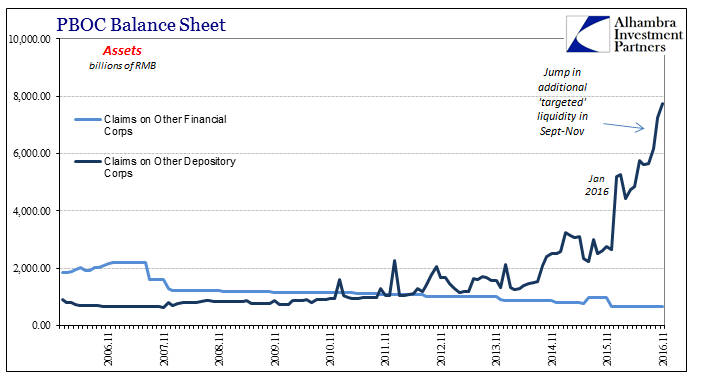
Some of these we are already quite familiar with; others are literally “other.”
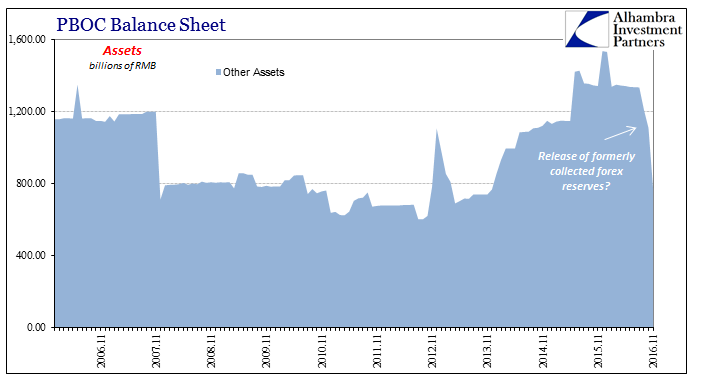
Any accounting system down to the least sophisticated leaves a miscellaneous category. In central banking and finance in general, it is downright regular to find huge balances described only as “other.” Perhaps the most famous example was the Federal Reserve finally giving in for reclassification in April 2013. Up to that point, due to the QE’s at that time still very much in effect, its Other Federal Reserve Assets line had swelled to $240.8 billion, triggering all kinds of conspiracies about how the US central bank was stealth buying different asset classes beyond what was authorized under the terms of the QE’s. Instead, it was just central bank accounting where what went into the specific balance sheet items was the par value of the securities purchased, leaving any premiums paid to be added elsewhere as “other.”
For the H.4.1 update on April 18, 2013, Other Federal Reserve Assets were presented as just $26.7 billion, while a new line appeared above it mixed in with the other QE acquisitions totaling $194.3 billion in unamortized premiums (as well as almost $2 billion in unamortized discounts given its own separate line). This was, however, one of the few times any central bank has given special notice for ambiguity.
I will state categorically that I don’t know what is responsible for the decline in the PBOC’s Other Assets; and though I can’t say for sure, it is still worth pointing out the rather large decline over the past three months. In the past, various leftover reserve schemes have found their way into that balance sheet line, particularly those relating to FX and forex swaps/derivatives. In 2007, for instance, the PBOC requested that the 14 largest Chinese banks deposit with it RMB denominated liabilities in the form of foreign currency. That appeared under Other Foreign Assets, as has the latest forex reserve scheme implemented last October, but has a corresponding balance debited under Other Assets (though we still have to account for changes in Other Liabilities).
Over September, October, and November, the PBOC’s Other Assets have been stripped of RMB 564 billion, a sizable sum that occurs during some of the worst of Chinese money markets – as well as CNY depreciation that spells out “dollar.”

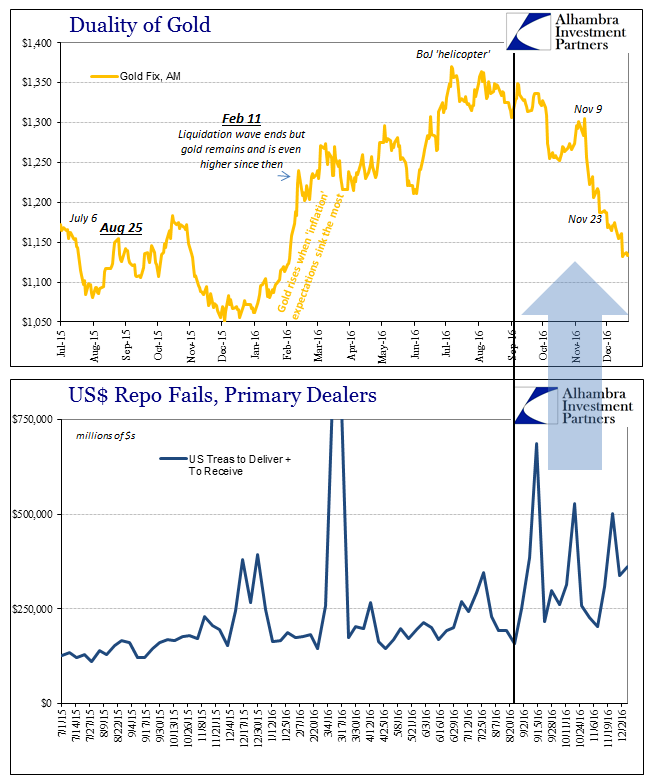
All of this is taking place as the view from domestic and Western markets (though conspicuously lacking even comparative depth) and more so the media is almost totally the opposite. Euphoria reigns as if a new day has already dawned. In many ways it is the reverse of 2007-08 prior to July 2008. Then it was domestic turmoil and overseas, primarily Asian bliss, too many “dollars” as it was. Now, like 2013, it is primarily Asian turmoil and domestic bliss, undoubtedly too few “dollars” across the world.
History shows us in each of these episodes that unless the “dollar” as a complete system gets fixed, these often different parts of that eurodollar system doing often very different things will eventually start to do the same thing at the same time. That’s the actual baseline that remains, and it is one that is more clearly displayed by China’s RRR (especially in relation to the currency rate) than maybe anything else in the world. China’s problems aren’t really its own, as its struggles are emblematic of our own. The word is “dollar”, not “capital outflows” or “hot money”, as it is all really persistently malfunctioning global money.
